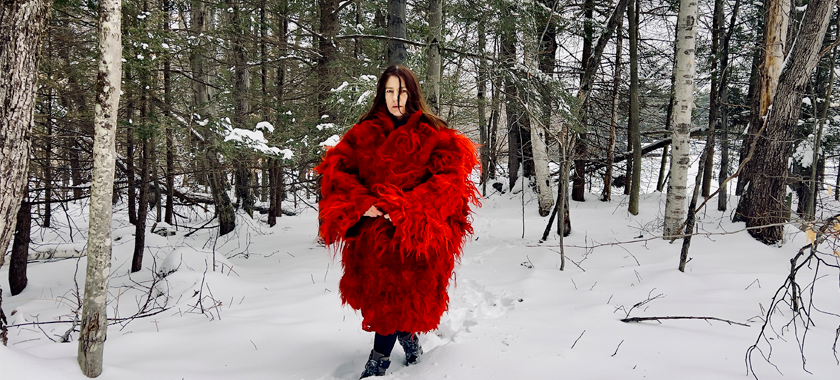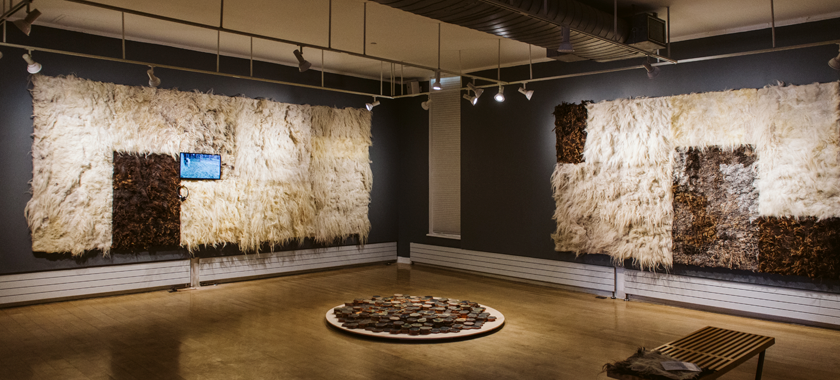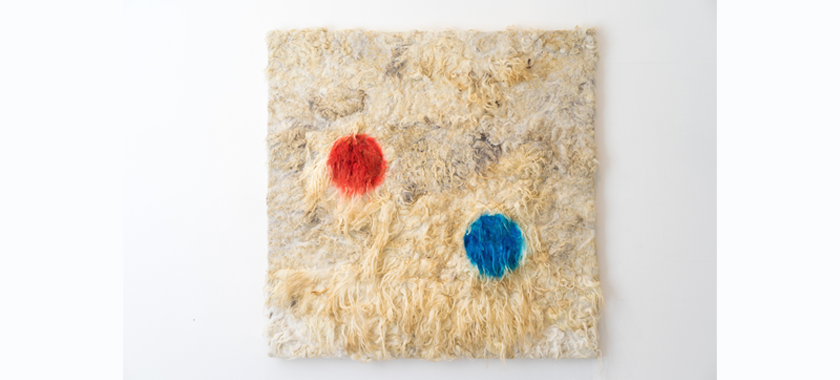
Finding Solitude and Building Community: Brigitta Varadi on the Artist Residency
ChaNorth Residency Director and self-taught artist Brigitta Varadi shares the “How” and “Why” of artist residencies and tips on applying for one.
Hungarian-born interdisciplinary artist Brigitta Varadi talks about what she worked on during her MacDowell residency, how her art practice has benefited from artist residencies, and her vision as the Residency Director at ChaNorth.
New York Foundation for the Arts (NYFA): Let’s talk about the artist side of you first—tell us about your practice and what you worked on as a MacDowell fellow.
Brigitta Varadi (BV): I mainly worked on a solo show titled Permission to Be, coming up in March 2024 at Kapow Gallery in New York, NY. Through an interdisciplinary approach, I explored my Carpatho-Rusyns cultural heritage by incorporating colors, textures, performance, and video work evoking my memories of many summer childhood stays with my great-grandfather in Tyushka, a small mountain village in Zakarpattia Oblast, Ukraine. I made a red Hunia, a traditional shepherd’s wool raggedy coat, and filmed my performance in different outdoor locations on the MacDowell grounds.
The project is the continuation of my investigation of disappearing traditions. The focus here is my own cultural heritage, drawing attention to the disappearing tradition of a small ethnic group. My work weaves in my own personal narrative, and sheds a light on their survival (110,000 people officially identified). This ethnic group is vanishing, in part because over time they mix into their surrounding communities and in part because they live in an area that was subject to many wars and claimed by many countries throughout the centuries.
I am happy to share that Hunia, part of Permission to Be, was invited to be part of Who’s To Say I Am Awake; Are You?, a group show curated by Tara Foley at Geary gallery in Millerton, NY from June 10 to July 30.

NYFA: Other than MacDowell, you’ve been awarded several fellowships and residencies in New York and internationally (ie Civitella Ranieri Foundation, Wassaic Project, and Museum of Arts and Design) and are an IAP alumna. How did you locate these opportunities and what is your process when it comes to selecting and applying for opportunities?
BV: I always feel a pull towards certain residency programs, depending on my current artistic interests or aims, in addition to considering my restrictions like other commitments and having a full-time job. I applied for the NYFA IAP mentoring program, when I was a new immigrant who was looking to integrate myself into this, as aptly described, woven fabric of New York art life. I felt a need to learn how to exist as an artist in NYC, create my community, share and learn from other artists’ experiences.
The Museum of Arts and Design (MAD) studio residency felt like the right fit for my practice. I was working on a project Exploring the Invisible, which was commissioned by Burlington City Arts in collaboration with Shelburne Farm, curated by Heather Ferrell. The project had an element of community collaboration and the MAD Artist-in-Residence is a community engagement program designed to encourage visitors to meet the artist.
I am always in search of residencies. I realized early on in my practice that I needed uninterrupted time to be able to develop my next project and complete it in my own studio. I used NYFA Classifieds and ResArtis to do my initial research and then I started to learn more from other artists.
Once I took part in a residency, I learned from my artist community what residencies are out there and could be an appropriate fit for my practice. Making long-term friends, sharing meals, and having conversations into the night with other artists is as critical for me as my well-guarded solitude in my studio. Art residencies have greatly helped me grow my network and build relationships with art professionals. New opportunities have arisen from there.
Making long-term friends, sharing meals, and having conversations into the night with other artists is as critical for me as my well-guarded solitude in my studio. Art residencies have greatly helped me grow my network and build relationships with art professionals. New opportunities have arisen from there.
-Brigitta Varadi
I was nominated to apply for the Civitella Ranieri Fellowship, where I worked on and created an installation in the Castle Gallery, “We Are Not Meant to be Seen – Angela.” It was a multimedia exploration of local labor, tradition, womanhood, and their relationship to the present. The project grew out of conversations between a local resident from Umbertide, Italy, named Angela Pauselli and I, and it came out of a desire to give new meaning to symbolic objects that belong to the past.
NYFA: Other than practicing your art, you are also serving as the ChaNorth Residency Director at ChaShaMa. Talk about how your arts career evolves and your vision as the director of the program.
BV: I am a self-taught artist. Throughout my experience, art residencies have served as a platform for learning on so many levels. Early on in my practice, I met people who supported my work, shared their experiences, and encouraged me. Without those mentors I would not have been able to develop my practice and grow as a person. I felt it was time for me to give back and share. I felt very strongly about building a program that would serve emerging artists in every way we can.
Drawing from my own experiences, we slowly built a program with the mission to support artistic dialogue. We offer emerging and mid-career artists an environment that fosters cross-disciplinary exchange of ideas, perspectives, and expertise, and provide the artists networking, exhibition, and teaching opportunities. During the ChaNorth residency, artists have multiple opportunities to share their work and network with others, including 2-3 studio visits per session from critics, curators, gallerists, and residency directors. We set up a fellowship award for young artists under 30. We nurture a strong alumni community through our alumni solo show award and yearly curated alumni shows presented at ChaShaMa exhibition spaces in New York City.

NYFA: Based on your experience reviewing applications for ChaNorth and sitting on other review panels, what advice would you give to emerging immigrant artists who are looking to build an arts career in the U.S.?
BV: Research. Do your research. Inform yourself of the residency—its location, what the residency offers, the studio setup, facilities, and whether there are any obligations to the artists. This will also help you form a clear statement of your interest and intentions during the residency.
Your images will be the most significant elements of your application. Keep in mind that the jury panel is viewing hundreds of applications. The clearer the narrative of your work through your images, the better the panelists will be able to understand your work. Your images should speak for themselves without reading the artist statement, as sometimes in the first few rounds the jury only views the images. Provide high quality images. If necessary, add only one detail element. If it is allowed, add a gallery view and an image that shows the scale of your work.
Artist statements should be brief, not longer than requested. Make it sincere and grounded in your art practice. Avoid “art speak” and jargon. State who you are, what, why, and how you make your work.
Keep applying and know that the selection process takes many factors into account, so rejection is not a reflection on your work. Keep applying as it shows your work to the judges who are also panelists on many other residencies, grants, and awards applications. They will continue to see your work and might follow your practice. Be patient with yourself, and embrace the opportunities you are given.
Keep applying and know that the selection process takes many factors into account, so rejection is not a reflection on your work. Keep applying as it shows your work to the judges who are also panelists on many other residencies, grants, and awards applications.
-Brigitta Varadi
Brigitta Varadi will present in the upcoming NYFA online public program “Writing & Talking About Your Work” on Tuesday, March 28 at 12:00 PM ET. The program is pay-what-you-wish. Please register here.
ChaShaMa is looking to highlight the art of Immigrant Artists with Anita’s Way: Immigrant Artist Performance Award. Applications are due on April 1, 2023. Please click here for current ChaShaMa opportunities.
About Brigitta Varadi:
Brigitta Varadi is a Hungarian-born self-taught artist who lives and works in Pine Plains, NY.
Varadi is a 2021 NYSCA/NYFA Artist Fellow in Interdisciplinary Work and a grant recipient from The Arts Council of Ireland, Leitrim County Council (Ireland), Roscommon County Council (Ireland), and Culture Ireland. She has been awarded residencies at MacDowell (Peterborough, NH), the Museum of Arts and Design (New York, NY), Civitella Ranieri Foundation (Umbria, Italy), NARS Foundation (New York, NY), The Marble House Project (Dorset, VT), Wassaic Project (Wassaic, NY), LOCIS-European Cultural Program (Sweden, Poland, Ireland), and Leitrim Sculpture Centre (Co.Leitrim, Ireland), among others.
Her work is found in public collections including a site-specific government commission for The Department of Education and Science, Athlone, Ireland, in addition to a recently-completed collaborative public art commission for Sligo County Council, Ireland.
As the Residency Director of ChaShaMa North (ChaNorth) nonprofit organization in New York City, Varadi supports the artists community through creating diverse programming and an environment that fosters cross-disciplinary exchange of ideas, perspectives, and expertise.
–Ya Yun Teng, Program Officer, Immigrant Artist Resource Center (NYC)
This post is part of the ConEdison Immigrant Artist Program Newsletter #157. Subscribe to this free monthly e-mail for artist’s features, opportunities, and events. Learn more about NYFA Immigrant Artist Mentoring Program.